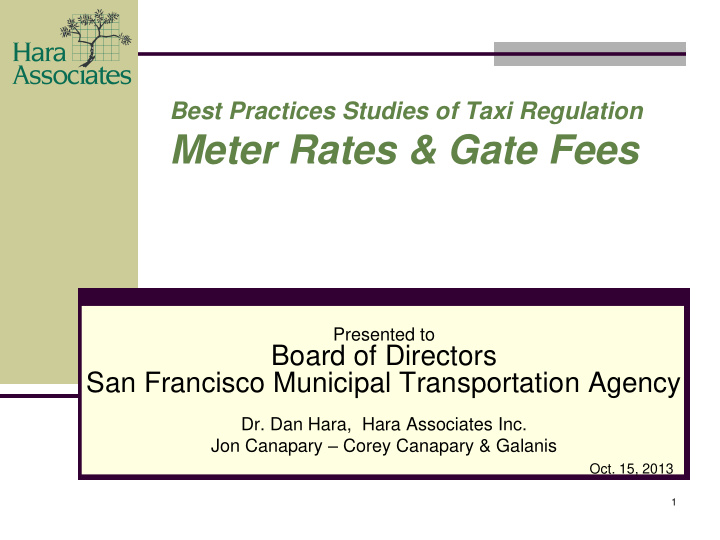



Best Practices Studies of Taxi Regulation Meter Rates & Gate Fees Presented to Board of Directors San Francisco Municipal Transportation Agency Dr. Dan Hara, Hara Associates Inc. Jon Canapary – Corey Canapary & Galanis Oct. 15, 2013 1
Background This is the second of a series of studies – still to come are enforcement and administration, driver training, vehicle standards. Key Topics: Current meter rates & fare structure Gate fee caps Ongoing adjustment formula/method Credit card acceptance by drivers & passenger information monitors (PIMS). Responding to competitive challenges Cost squeeze on companies and 3 rd party leasing Evolving context from Public Utilities Commission decisions on shared ride service/ transportation network companies (TNCs) 2
Presentation Plan Review key points of taxi industry structure and current challenges. Outline principles guiding the recommendations Speak to report recommendations 3
Basics . . . The meter pays for it all Figure 2.1: Where a dollar from taxi fare goes Gas Supplier Driver Taxi Driver Cell phone Other expenses Take home $1 Paid By what’s left Customer to Driver Medallion Holder Gate Fee Taxi Company Vehicle and equipment SFMTA Dispatch ● Inspection ● Licensing Insurance ● Enforcement Licensing Overhead, etc. Fees 4
Challenges . . . Costs are up In two years since 2011 meter rate adjustment – insurance up from $6700 to as high as $10,400 Overall costs up by approximately 5.8% Gate fee paid to companies has not changed since 2008 – and companies (color schemes) pay the insurance. But SF meter rates already high relative to other cities (reflecting higher operating costs). 5
Challenges . . . New Competition Limousine services (e.g. Uber) enabled by apps cut into street hail business. Transportation Network Companies enabling unregulated taxi operation (faux shared-ride). Taxi demand still strong, but driver shortage is a growing problem. Unrealistic, unsustainable, insurance situation. Ability of taxi companies to respond with own apps is limited by restrictions on rates (e.g. cancellation fees and ease of credit card use) still limited supply of taxis 6
Challenges … Credit card acceptance & PIMs SF driver resistance to credit cards continues. Don’t want to pay 3.5%, don’t want fees, many use Square at 2.75%. A customer service problem for the industry. Business case financing PIMs is also undermined. 7
Challenges . . . Cost Squeeze on Companies Noted in previous report. Same gate fee cap paid to companies whether high dispatch service or not. Further squeeze from third party agents bidding up medallion lease prices (with less assured regulatory compliance) Impact on public safety: taxis being operated by individuals without SFMTA license – risk of non- compliance on safety, driver hours and qualifications, gate fees, etc. 8
Principles for recommended strategy Now is not the time for broad rate increase. Strengthen the brand. Value to customer linked directly to any rate changes. Relief for higher costs. Quantity matters. 9
Credit Card acceptance & PIM Options Do Nothing A. Credit Card User Fee B. C. Fixed Fee Per Trip (35 cents) D. Fixed Fee Per Shift ($6.25 per shift) Fixed fee options both good and feasible. Solve incentive problem for driver and financing problem for PIMs On balance – recommended fixed fee per shift – gets SFMTA out of setting rate and easier to explain to drivers. Both options better with adding 35 cents to the meter. Acknowledge reluctance of SFMTA staff in light of not increasing meter at all. In long run – something must be done here. 10
Improving Dispatch Service Cancellation fee for credit card customers. Rewarding better dispatch – variation in gate fees (up to 4%). Alternative: different gate fees by equipment and/or minimum standards (dispatch equipment, staffing, garage, fleet size, etc.) Problem: Is this the right use for scarce enforcement resources? Previous recommendations on expanding fleet. Accelerate fleet expansion to meet competition 11
Innovation: True Shared Ride Maximum flat rate $11.00/person At driver’s option, and passengers consent Not for every driver but could involve: Transportation nodes Entertainment areas Smartphone and dispatch innovation May or may not have uptake Staff paper: step-by-step based on rules by Director Achieves true shared ride where two or more trips are combined. 12
Reducing Cost Squeeze on Companies & Improving Public Safety Two problems – same source: Safety problem: regulatory oversight difficult with 3 rd party brokers. Cost squeeze on companies. Require vehicle and insurance be either provided by: Medallion holder themselves, or color scheme. 13
Gate fees Problem: gate fees and meter rates not always adjusted at same times. See-saw in income distribution. Between 2006 and 2011 – no meter rate adjustment. 2011 saw 20% meter increase – but no gate adjustment. Which deal to preserve? Before or after? Giving 20% gate now – means around $5,000 annual reduction in non-medallion driver income (to pre 2011 levels). Final recommendation: Increase cap by $9.75/shift. At high end of driver suggestions, low end of company suggestions. Effect likely delayed – given driver shortage. Flexibility gives companies security to plan future – take initiatives to deliver more value to customers, drivers, and medallion holders. 14
Formula for future rate adjustments Adjust gate and meter at the same time. Cost index approach recommended. Based on SF cost profile – but updated using public formula and publicly available data. Computer spreadsheet tool will be provided. 15
Thank you! Questions and Discussion 16
Recommend
More recommend